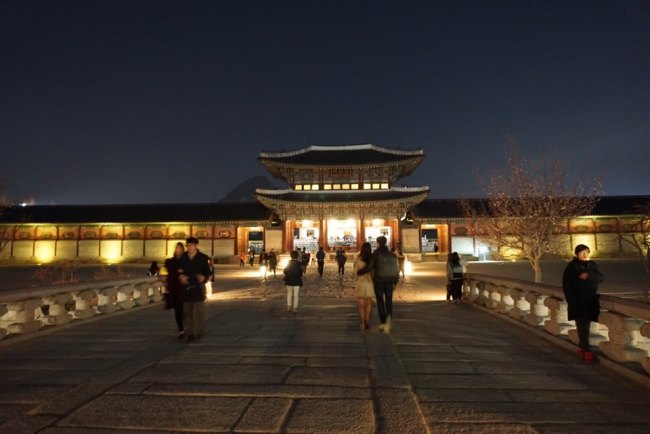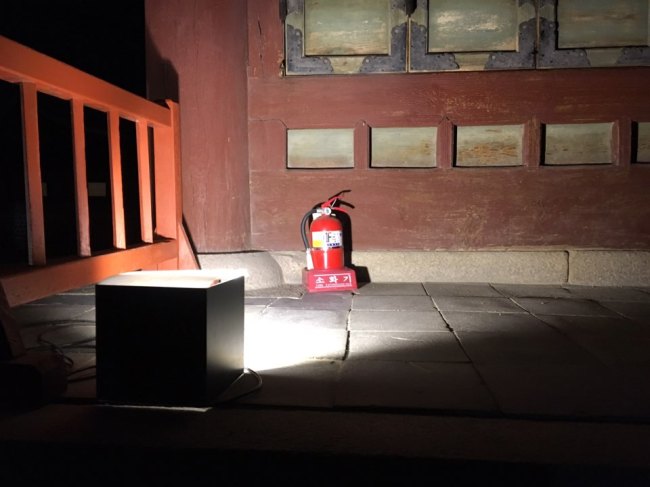“I managed to get the last batch of tickets,” said 29-year-old Tina Hsing, a Chinese student here, standing in front of the main gate of Gyeongbokgung Palace in downtown Seoul after sunset.
She said she really did not want to miss the chance to experience Korea’s royal palaces under the moonlight.
“I heard tickets (to enter Gyeongbokgung Palace during night hours) are sold out in minutes for domestic visitors, which makes me glad that I am a foreigner here,” said Hsing.
 |
| Visitors take a stroll around Gyeongbokgung Palace during the nighttime opening on March 31. Kim Da-sol/The Korea Herald |
True to what Hsing said, ticket openings to this year’s night opening of Gyeongbokgung Palace — a total of 25,000 tickets — hosted by the Cultural Heritage Administration never lasts for more than a day.
A nighttime entrance ticket is sold at 3,000 won ($2.60) and is only available at interpark.com, an online ticket seller, for locals.
Due to its popularity, the number of ticket scalpers has also been increasing.
The nighttime opening of Gyeongbokgung Palace started in 2011, with no limit on the number of visitors. It was opened for five days twice a year, before extending the after-hours operation to 120 days from March to June as its popularity grew.
According to the CHA, the number of visitors varies depending on the weather. On a rainy day, around 1,700 people visit the palace at night, while the number is well above 2,100 on warmer nights.
Security loopholes
But despite the soaring number of visitors each year, safety loopholes have become prevalent especially at night.
 |
| A fire extinguisher is placed next to the building at Gyeongbokgung Palace. Kim Da-sol/The Korea Herald |
The CHA said there are no special measures taken to protect the centuries-old palace buildings except for checking the fire extinguishers, light bulbs and electricity lines on a daily basis.
As of 2015, there are 510 fire extinguishers and 230 surveillance cameras installed across the 432,703-square-meter plot of Gyeongbokgung Palace.
On one of the nights the palace was opened in the evening last month, a transparent box installed in front of the main entrance to collect banned items from visitors only contained two cigarette lighters. At the time, at least 300 visitors had passed the main gate in the past hour. Security staff said they did not have authority to search each individual’s bag.
“Although most visitors do not hand in inflammables (that they may be carrying), there are CCTVs in every corner to check if anyone is smoking or starting a fire,” said a staff member standing next to the box.
Unlike other famous tourist spots like Louvre Museum in Paris, Gyeongbokgung Palace does not require inspection of visitors’ belongings, nor do they have a scanning machine or metal detectors at the entrance.
Following the 2015 deadly terror attack in Paris, the city immediately upped the number of security guards and detecting machines at museums and even at public shopping malls, to ensure the safety of visitors as well as security inside the buildings.
Such preventive measures do not appear to apply in one of the most visited tourist spots in Korea, seven years after the No. 1 National Treasure Sungnyemun Gate in downtown Seoul was burned down in an arson attack by a local.
Located at the heart of the capital city, Gyeongbokgung Palace was the first palace built at the beginning of King Taejo’s reign in 1395. Its name translates to “palace greatly blessed by heaven,” although it has had a traumatic history.
The palace is still undergoing restoration, since 90 percent of the buildings were burned down during the Japanese invasion in 1592. Despite such history, the palace attracts hordes of local and foreign visitors day and night, as it is easily accessible by public transport.
Short-staffed
In addition to the lack of safety equipment and regulations, the lacking number of security guards is seen as another loophole.
“We are all hired by an outsourcing company through the Cultural Heritage Administration. We did receive the basic education on the palace map and security guide, as it is our first month here,” said 60-something man Ki Yong-do, wearing a bright orange vest with a “staff” nametag.
“We have a designated zone to look around, keeping visitors away from the closed parts of the palace,” added Ki. But he said his main role is limited to that.
The CHA said that 46 out of 53 part-time security staff have been hired just for this year’s night opening through online applications. The rest of the hired staff work at the ticket booth.
To control the swelling number of visitors as well as security at night, it was inevitable to request an outsourcing company to hire part-time staff due to shortage of hands, as the number of areas opening to the public keeps increasing each year, authorities said.
“From this year, we also opened the areas near five buildings behind the main Geunjeong Palace including a garden near Mount Amisan, while just two buildings were open to public until last year,” said an official at Gyeongbokgung Palace management team.
More beautiful at daytime
Unlike European architecture mainly comprised of stone walls, Korea’s Gyeongbokgung Palace has wooden walls, delicately decorated with painting, wood, paper and tiles. Analysts say that’s why it is so beautiful, especially when seen in its natural surroundings without excessive lighting.
“Korea’s unique painting and way of stacking roof tiles is something that cannot be redone over several years. That’s why it is taking over a decade to choose the right tree for restoration,” said an official at National Research Institute of Cultural Heritage.
“It’s actually prettier during daytime, as the colors revive under the sun.”
According to Bae Su-kyung from CHA’s facilities division, lighting up the palace was based on requests from visitors taking professional photographs.
“As we are aware of the possible fire hazard from lighting bulbs near the building, we instead use indirect and minimum lighting to create the ambience, by finding the perfect angle of light,” she added.
While some visitors constantly complain of the subdued ambience of the palace and the need for more lights inside, the authorities said they were not considering it for the time being, partly also due to high cost.
Gyeongbokgung Palace management authorities also added that the most imminent nuisance for them is to fight off the ticket scalpers.
“We requested the police to help us by stopping those scalpers. But we were told that there is no legal ground to sue or investigate them,” said Bang Gun-ho, an official at the Cultural Heritage Center.
Most of the illegal ticket purchasing happens at online cafes where identities of sellers and purchasers are not revealed.
“Every measure has been taken so far to reduce illegal ticket purchasing. But to be honest, we have kind of given up,” said Bang.
By Kim Da-sol (ddd@heraldcorp.com)

